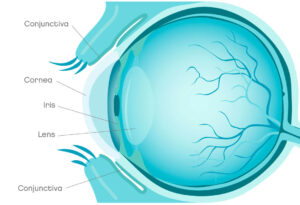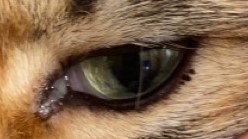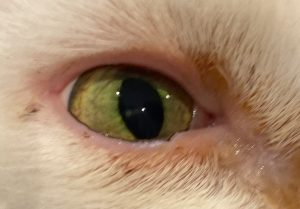Conjunctivitis in cats is often associated with cat flu infections. Most cases are not serious and clear with prompt treatment. Any breed or age of cat can develop conjunctivitis; however, it is more common in young cats and kittens.
Conjunctivitis or “pink eye” is one of the most common causes of red, inflamed eyes in cats. It occurs when the conjunctiva is irritated or infected. Cats can spread some infectious forms to each other. It’s recommended that you speak to a vet to see if your cat needs medical treatment.
Overview
What is conjunctivitis in cats and what are the causes?
This condition refers to redness and inflammation of the conjunctiva.
The conjunctiva is the tissue that covers the inner surface of the eyelids and the white part of the eye (sclera).
Both eyes are usually affected, but it can also affect just one.
Conjunctivitis is mostly caused by viruses and bacteria.

The most common viruses and bacteria responsible for conjunctivitis are often seen with cat flu disease (such as Herpes virus, Calicivirus, and Chlamydia).
Other causes include:
- Eye ulcers
- Trauma
- Foreign object (such as grass seeds)
- Parasites
- Immune-mediated diseases
- Systemic diseases (cats with these diseases usually have other signs of illness) examples: feline immunodeficiency virus (FIV), feline leukaemia virus (FeLV), or feline panleukopenia
- Allergies and environmental irritation (dust, smoke, chemicals, air fresheners)
- Glaucoma (a disease that increases the pressure inside of the eye)
- Uveitis (inflammation of the middle layer of the eye)
- Tear duct diseases
- Eyelid and eyelash problems
- Eye tumours
If left untreated the condition can be harder to treat and lead to severe eye issues.


Symptoms
How to tell if your cat has conjunctivitis?
You might see some or all of the following symptoms in your cat:
- Eye discharge (yellow, green, or clear)
- Pink or red eye
- Pawing or rubbing at the face
- Blinking more than usual or squinting
- Swelling of the tissue that lines the eyelids and surface of the eye (conjunctiva)
- Inner corner of the eye membrane (third eyelid) more pronounced
Risk
Are some cats more likely to get conjunctivitis?
High population density (such as animal shelters and multi-cat households):
- Cats that live with multiple other cats are more prone to conjunctivitis due to infectious causes (virus, bacteria).
- Good hand hygiene between handling and medicating infected cats is essential.
- Separating these cats during the illness period will help prevent the spread of the disease to the other cats.
Kittens
- Are usually more severely affected than adults because they find it harder to fight infections.
- However, the outcome is still very positive, unless the kitten presents with more severe symptoms of cat flu.
Cats with a weakened immune system
- These cats may have more difficulties getting rid of the symptoms or may also experience more flare-ups.
- This includes cats with immune-mediated diseases or systemic infectious diseases (i.e. feline immunodeficiency virus (FIV), feline leukaemia virus (FeLV), or feline panleukopenia).
Stressful environment or episodes of stress: can be a cause of the relapse of infectious conjunctivitis.
Flat-faced cat breeds: Brachycephalic cat breeds such as Persian, Himalayan, and Exotic short-hair are at a higher risk of conjunctivitis due to an increased risk of eyelid and tear duct abnormalities. Click here to read more about BOAS in cats.
Is conjunctivitis in cats contagious to humans?
Even though it’s very unlikely you will get conjunctivitis from your cat, you should always wash your hands after applying medications or touching your cat’s face during treatment.
Diagnosis
How is conjunctivitis diagnosed in cats?
Because there are many different causes of conjunctivitis, vets may need to use various tests to help confirm your cat’s diagnosis:
- Visual examination
- Dye test
- Tear production test
- Test the pressure inside the eye
Vets will sometimes take samples for special tests to send to a lab. This may include:
- Bacterial culture and sensitivity testing
- Testing for viruses
- Blood tests to check for other illnesses affecting the body
Because of their temperament, vets may need to sedate your cat in order to check their eyes thoroughly, especially if a foreign body is suspected.
Vet treatment
What are some of the treatment options for conjunctivitis in cats?
The course of this medical problem depends on the underlying condition. In most cases, it can be easily resolved. Treatments include:
General treatment for mild conjunctivitis:
- Eye cleaners: drops, wipes
- Lubricating, soothing treatment: gels, ointments, drops
Prescription medicines depend on the underlying cause:
- Anti-viral: oral medication
- Antibiotics: gels, ointments, drops for the eyes or oral medication
- Steroid anti-inflammatory: drops or ointment for the eyes or oral tablets
Other treatments or surgery may be necessary to treat the underlying cause of conjunctivitis. Glaucoma and eyelid problems are two examples.
Home treatment
Things you can do at home to help ease the symptoms of conjunctivitis in your cat
Use sterile saline to flush the eye:
- Use a cotton ball soaked in saline solution to flush a few drops into the eye 2-4 times daily.
- Clean any accumulated discharge around the eye using a cotton pad.
- Sterile saline is available in pharmacies. You can make your own at home by using cooled-down boiled water.
Use a buster collar on your cat: preventing damage to the eye is important, as cats may scratch at their eyes with their paws or rub their faces on furniture.
Do not use human medication on your cat: always speak to a vet first.
Tips on how to live with a cat with ongoing conjunctivitis
Once your cat has been seen by a vet, there are some things you can do at home to help this recurrent problem:
Wipe their eyes and nose regularly
- Use a cotton wool pad soaked in warm water to wipe any discharge from their eyes and nose.
- It will help your cat feel better, smell their food, breathe more easily, and avoid discharge buildup.
- Take care not to do it too frequently. This can lead to a sore nose and eyes.
Reduce stress: keep your cat’s life as stress-free as possible because stress can make certain illnesses worse or cause a relapse.
Prevention
Is there any way to prevent conjunctivitis in cats?
In multi-cat households, conjunctivitis is less likely to spread to other cats if cats with conjunctivitis are separated.
Getting your cat vaccinated against cat flu can help with prevention.
When to worry
When do you need to call the vet if your cat has conjunctivitis?
If your cat shows any of the following signs, call your local vet:
- Squinting or inability to hold the eye(s) open
- Signs of pain, including pawing at the face
- Signs of systemic illness: tiredness, decreased appetite, vomiting, or diarrhoea
- Failure to improve despite treatment
Call us at Joii if your cat has any of the following:
- Discharge from the eyes and nose
- Eye redness or squinting
- Sneezing
- Nasal congestion
- Coughing or wheezing
- Mouth, nose or lip wounds
- Stress
- If you’re not sure, it’s best to be safe








